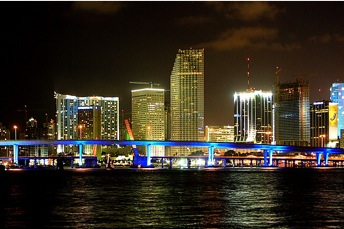
Photo courtesy of totalAldo
Downtown is a hot topic right now. The flip side to South Beach and its all-nighters, the Central Business District, Media & Entertainment District and Brickell comprise the corridor spearheading a Downtown renaissance. Ever since the early 1900s, when John Collins and Carl Fisher bankrolled a project dredging the area that eventually became Miami Beach, there’s been the lure of the sand, the sun and marathon cocktail parties. Today, people are again inspired by the cityscape on the opposite end of the MacArthur Causeway, where the investment of several billion dollars means that downtown is rising again.
Up close, downtown is just as dramatic. Case in point: Brickell. This neighborhood is bounded on two sides by water — The Miami River and Biscayne Bay comprise a picturesque counterpoint to the sheen of Brickell Avenue. Known as the “Wall Street of the South,” this thoroughfare is the center of downtown’s renewal, embodying the geist of the city. Impressive chrome-and-glass skyscrapers combine businesses, retail and brilliant condo space — mixed-use nirvana with infinite views. According to the Miami Downtown Development Authority, there are no less than eight recently completed projects throughout the Brickell neighborhood, with price tags ranging from $47 million to $380 million.
That’s just today’s downtown. They’re already hard at work on tomorrow’s Miami, with a dozen construction projects in Brickell spearheading the move forward. The downtown skyline will be changing on a monthly basis for the foreseeable future.
Beautification projects involving Biscayne Boulevard and Flagler Street bring a new energy to these historic areas. You can see it from above on the MetroMover, an elevated, air-conditioned coach system that traverses the Central Business District. In addition, loops travel to Brickell’s Financial District and north to the Media & Entertainment District, where the $400-million Performing Arts Center, opening in 2006, will be home to local arts organizations. In addition, an annual residency by the Cleveland Orchestra is currently in the works.
The MetroMover is one of the best ways to tour downtown, with stops at, among other locations, Bayfront Park and the Miami-Dade Cultural Center. This new-age “El” is the perfect mode of transportation for such a forward-looking city. And fun, too — it’s a little like being in Disney World, with skyscrapers.
Lest you think that downtown Miami is being swallowed up by steel and glass leviathans, look again. The Miami-Dade Cultural Center serves as a focal point for the area, with a sleek design combining a welcoming public space with a couple of choice museums. At the Miami Art Museum, postmodern works are the order of the day. Installations, video presentations, sculpture, graphics and paintings from their collection are well worth perusing. Right across the plaza, the Museum of Southern Florida offers insight into Miami history. Historical photos point out the contrast between downtown’s first business district, makeshift wooden buildings on what is now Miami Avenue, and today’s brilliant cityscape.
You’ll see the same contrast on a tour of the Central Business District, where there is a constant tug of war between the entrepreneurs and the preservationists. But even in Miami, as developers urge the landscape perpetually forward, there are glimpses of decades past. The 1928 Dade County Courthouse, a Federal-style classic originally built for $4 million, will soon be retired — a new $120-million courthouse is under construction around the corner.
Other vestiges of the old downtown surround the intersection of East Flagler and N.E. 2nd Avenue. These include the Italianate Ingraham Building, with its art deco lobby, and the 1939 Alfred I. DuPont Building, which has been compared stylistically to Rockefeller Center. The Moorish Olympia Building, which houses the Gusman Center for the Performing Arts, is just across N.E. 2nd Avenue from the art moderne gem that was once Walgreen’s flagship store.
On Biscayne Boulevard at Port, there’s perhaps the perfect juxtaposition of old and new Miami. The 1925 Freedom Tower stands hard by the state-of-the-art American Airlines Arena, an illustration of how far the city has come. The tower, a stately Mediterranean Revival building once home to the Miami News & Metropolis, lends a romantic flair to the big-city thoroughfare. The arena across the street is a streamlined venue for the twenty-first century. This is the home of the NBA’s Miami Heat, led by center Shaquille O’Neal, and a great place for a concert. The venue hosted the MTV Video Music Awards in 2005 as well — red carpets and limousines are the perfect complement to this gleaming entertainment venue. With the direction downtown continues to move in, Miamians envision a day when the buildings downtown will make the AA Arena look like the Freedom Tower.
You can still get an eyeful of downtown Miami’s glorious Here and Now on a bay cruise. As you pull out of the Bayside Marketplace harbor, just as you pass Parrot Jungle Island, get a good look. Take a picture or two of that photogenic skyline for posterity. It will be even bigger tomorrow.
(Published in Miami magazine)



